I had the opportunity to visit Milan again (see below) for business as part of my European assignment. The company's Italian office is in the same neighborhood we visited in 2002, so I felt that I could find my way around. This only resulted in me getting ripped off once.
I arrived at Milan's Linate airport from Brussels, after a very pleasant taxi ride from Breda, the Netherlands, where I'm staying for a short-term overseas assignment. Linate is just northeast of downtown Milan, so I thought a taxi ride from the airport to the Garibaldi Gate neighborhood would be relatively inexpensive. It would have been very economical had I chosen the shuttle bus (about one Euro), or found my way to the "real" taxi stand. However, I was snagged by (what I thought) was a taxi driver, and ushered to a big Mercedes. The ride was comfortable, and got me where I needed to go, but it cost over half the price of the taxi trip from Breda to Brussels! I promise to be more careful next time - really!. My only consolation is that numerous others have written about the same rip-off at Linate. Beware!
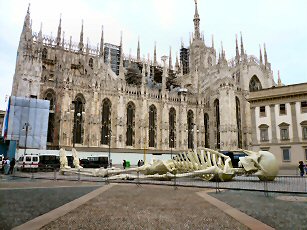 My business meeting was on Friday afternoon, and with another in Germany Monday afternoon, I decided to stay in Milan for the weekend. The chic AC Hotel, near the Garibaldi Station, was to be my base of operations. Even more convenient, it was so close to the Amgen offices that I could use the Amgen WiFi!
My business meeting was on Friday afternoon, and with another in Germany Monday afternoon, I decided to stay in Milan for the weekend. The chic AC Hotel, near the Garibaldi Station, was to be my base of operations. Even more convenient, it was so close to the Amgen offices that I could use the Amgen WiFi!
Saturday turned out to be Italian Independence Day, and after breakfast I was warned by the hotel staff that not too many restaurants would be open - I think they were trying to drum up business, as it turned out not to be true. I set off on foot towards the center of Milan. The festivities were definitely underway as I found myself in the Duomo Plaza; unfortunately it was also drizzling. This sight greeted me beyond the Duomo; I'm not quite sure about the significance of the skeleton's very long nose. Note the scale (that's an ambulance at the skeleton's feet!).
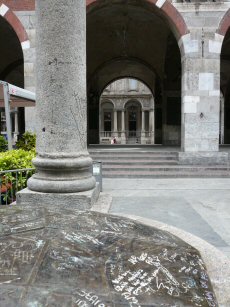 I also found my favorite spot in central Milan - a part of the marketplace that has been in continuous use since Etruscan times. The graffitti is somewhat newer, I'm sure.
I also found my favorite spot in central Milan - a part of the marketplace that has been in continuous use since Etruscan times. The graffitti is somewhat newer, I'm sure.
I had lunch at a sidewalk cafe, Sans Egal, which was very pleasant. So pleasant, in fact, I made it a point to return there the next evening for dinner, and on subsequent trips to Milan.
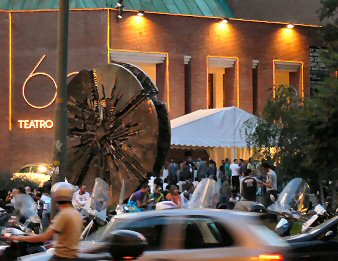 By evening, the scene was heating up, with music and dancing at every street corner. Here's just one example, in a neighborhood about halfway between La Scala Opera and the Garibaldi Arch.
By evening, the scene was heating up, with music and dancing at every street corner. Here's just one example, in a neighborhood about halfway between La Scala Opera and the Garibaldi Arch.
After dinner, I took the subway back to the Garibaldi Station and walked back to the hotel past the Arch, where a boxing ring had been set up. While enjoying a gelato, I watched the beginnings of a rock 'n roll boxing match, evidently also part of the independence day celebration.
My business colleagues had suggested a trip to Bergamo for Sunday, but I had long looked forward to seeing the city from which modern classical orchestration had sprung, Cremona, the home to the makers of violins and other string instruments. I bought my train ticket (2nd class - this was off the expense account), found the train, and sat down.
At the next stop, a young woman and her 5-year-old daughter got on, and sat down knee-to-knee with me in the facing seats. The little girl greeted me in Italian, and I replied by apologizing, in English, for not being able to speak the language. Her mother translated, and then the little girl started reciting her counting numbers, in English - the ice was broken! In their fractured English, and my totally inadequate Italian, we discussed why I was in Italy, going to Cremona, and where I was from, and many other things over the course of the hour-long train ride. The young woman was visiting family in Cremona, and mentioned that though the museums would be open there, that the violin makers would be closed on Sunday. That was fine with me, I explained; I was delighted to be able to visit Cremona at all.
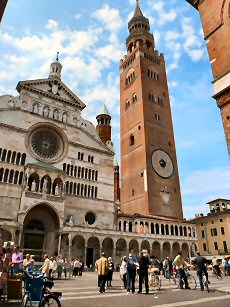 The woman pulled out her phone, made a call, and to my surprise I heard my name, "California," "Los Angeles," "Beach Boys," "Violin," and "laboratorio" in her conversation. She put the phone away, smiled, and said that her brother would meet us at the train station, and open his violin workshop for me to see. He is Stefano Gironi, one of only 14 certified and licensed violin makers in Cremona, and I had met his sister and niece! He met us at the train station, drove us to his home, and showed me his workshop - Wow! What wonderful hospitality!
The woman pulled out her phone, made a call, and to my surprise I heard my name, "California," "Los Angeles," "Beach Boys," "Violin," and "laboratorio" in her conversation. She put the phone away, smiled, and said that her brother would meet us at the train station, and open his violin workshop for me to see. He is Stefano Gironi, one of only 14 certified and licensed violin makers in Cremona, and I had met his sister and niece! He met us at the train station, drove us to his home, and showed me his workshop - Wow! What wonderful hospitality!
Stefano's studio is on the outskirts of the magnificent cathedral district (just beyond the tower in this picture). In addition to showing me his tools, forms, raw wood, and works in progress, Stefano was kind enough to make some very specific recommendations about what to see in his town, including the Amati, Guanari, and Stradivarius collection in the civic hall (featured in the recent New York Times article) as well as the collection in the civic museum. 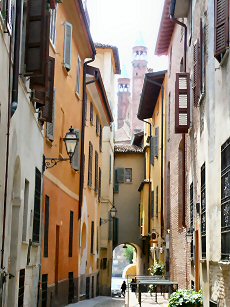 He also recommended the current art exhibit at a gallery tucked away down a street that I would have never found on my own. After visiting with him, I spent a delightful afternoon wandering, seeing all the exhibits he recommended, and strolling through the sleepy town on a hot Sunday afternoon.
He also recommended the current art exhibit at a gallery tucked away down a street that I would have never found on my own. After visiting with him, I spent a delightful afternoon wandering, seeing all the exhibits he recommended, and strolling through the sleepy town on a hot Sunday afternoon.
I returned to Milan, then found my way back to Sans Egal for a delightful dinner, walked to Statione Cadorna where I bought a train ticket for the next morning's trip to Malpensa Airport, and then walked north past the Sforza Castle and Stadium back to the hotel, arriving at dusk.
The next morning, I took a brief (and mercifully inexpensive) taxi ride to Cadorna, got the train to Malpensa, and off to Frankfurt! ...but that's another story altogether.
Carol had a short posting at Nerviano, Pharmacia’s R&D/Manufacturing facility outside of Milan, at the end of the school year in 2002. I met the kids at school, and we zipped over to the Detroit airport.
After a very brief stop in Frankfurt, our overnight flight landed in Malpensa, Milan’s ultramodern international airport, early in the morning. We rubbed the sleep out of our eyes, grabbed our luggage, and headed out. I was somewhat apprehensive about getting kids through Italian customs, but shouldn’t have been – we got to choose whether we had anything to declare or not (we didn’t) – and the “no declare” doorway dumped us directly out into the main terminal, where our driver was waiting (it’s nice to have a spouse that’s an invited guest at an international facility!). He had just dropped Carol off at the Nerviano facility, and came to airport to get us.
The drive into Milan from Malpensa was very reminiscent of driving into Chicago from O’Hare, except for the spectacular glimpses of the Alps to the north, which we’d just flown over on our brief hop from Frankfurt. There were more reminders of Chicago to come.
Our driver pulled up in front of “The Big House” (not a prison, just a non-idiomatic translation of the Italian, I guess), and dropped us off.
After picking up our keys at the desk, we looked at our room – actually a two-bedroom apartment – overlooking a busy street in northern Milan, near the Garibaldi Gate. We felt, and heard, rumblings and clankings outside, looked out, and saw another reminder of a long-ago Chicago – electrified streetcars on rails embedded in the roadway.
We took a very brief nap, then set out on foot to explore. We had many hours before Carol would return from Nerviano, so off we went.
The Garibaldi Gate is close to two major train stations in Milan, and not far (or so it looked on the map) from many sights in central Milan. We walked southward down the narrow streets, gaping at tightly-packed shopfronts, churches, and shady courtyards. My high-school Latin served me well in translating building inscriptions, and my recently-acquired information on the feudal families of pre-Napolean northern Italy helped to explain the strange insignia we saw – but more on that later.
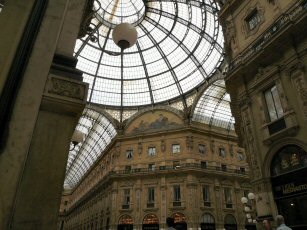 We emerged unscathed in central Milan, stumbling almost literally onto the Leonardo DaVinci statue between the Teatro de la Scala (otherwise known as the La Scala Opera) and one of the oldest shopping malls in Europe, the Galleria. The Galleria is a large cruciform building, open on the ends, with beautiful domed skylights, mosaic floors, elaborate shops and restaurants, and thousands of pigeons! One of the mosaics is a bull, and we obtained our requisite good luck by twirling around on its ceramic testicles (weird custom!).
We emerged unscathed in central Milan, stumbling almost literally onto the Leonardo DaVinci statue between the Teatro de la Scala (otherwise known as the La Scala Opera) and one of the oldest shopping malls in Europe, the Galleria. The Galleria is a large cruciform building, open on the ends, with beautiful domed skylights, mosaic floors, elaborate shops and restaurants, and thousands of pigeons! One of the mosaics is a bull, and we obtained our requisite good luck by twirling around on its ceramic testicles (weird custom!).
Just across the street from the Galleria is Milan’s Duomo, a brilliant white marble cathedral with a narrow, twisty little staircase up to the roof. We paid the surly attendant our admission, and mounted the steps to the roof, where we could readily see the skyline of Milan, the Alps, and the statuary festooned about. The marble was slick, so we were glad to have our rubber-soled shoes on. We returned to the plaza, where even more pigeons swooped and clustered. We visited a little shop in the Galleria Arcade and bought some crackers, and the kids fed the pigeons. At one point, Marianna had about 50 pigeons on her arms, head, and shoulders.
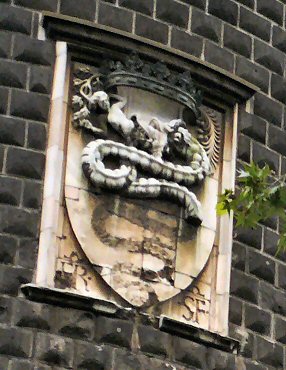 The central subway office is just below the Duomo Plaza. We purchased our week subway passes there (the first subway trip for Greg, ever), and then took the subway to the stop nearest the Sforza Castle, where we learned about the origins of the strange insignia mentioned above – a serpent devouring a baby. These emblems were everywhere: under rooflines, at the ends of stone gutters, etc. The Sforza family, heavy hitters in medieval and renaissance Italy, used this emblem to intimidate their foes (presumably the Sforzas were the serpents, and their foes, the babies). The weapons, armor, and artwork displayed in the castle were very stimulating, but the gelato we purchased across the street was, by that time, even moreso.
The central subway office is just below the Duomo Plaza. We purchased our week subway passes there (the first subway trip for Greg, ever), and then took the subway to the stop nearest the Sforza Castle, where we learned about the origins of the strange insignia mentioned above – a serpent devouring a baby. These emblems were everywhere: under rooflines, at the ends of stone gutters, etc. The Sforza family, heavy hitters in medieval and renaissance Italy, used this emblem to intimidate their foes (presumably the Sforzas were the serpents, and their foes, the babies). The weapons, armor, and artwork displayed in the castle were very stimulating, but the gelato we purchased across the street was, by that time, even moreso.
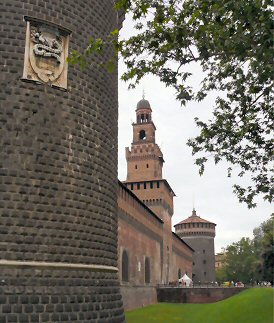 We walked back to central Milan from the Sforza Castle, and I got the feeling that I’d been there before. It only took me a moment to realize that this neighborhood, with its multistory buildings, big old trees, wide boulevards, and long vistas reminded me of Chicago. The neighborhood between the Sforza Castle had been razed by Napoleon’s city planners when Milan had been the capitol of Napoleon’s conquered Italy, and many of the French influences seen in Paris and Washington, D.C. also were used in Chicago.
We walked back to central Milan from the Sforza Castle, and I got the feeling that I’d been there before. It only took me a moment to realize that this neighborhood, with its multistory buildings, big old trees, wide boulevards, and long vistas reminded me of Chicago. The neighborhood between the Sforza Castle had been razed by Napoleon’s city planners when Milan had been the capitol of Napoleon’s conquered Italy, and many of the French influences seen in Paris and Washington, D.C. also were used in Chicago.
We had a great evening with Carol, once she returned from work. We had traveled half-way around the world, it seemed, and found a sushi restaurant for dinner! We settled into the hotel for the night, and were awakened early the following morning by the rumbling of the streetcars. Back to work Carol went, and while the kids slept, I visited my own colleagues at the Pharmacia office in the western suburbs of Milan. The taxi trip there covered much the same territory we had walked the previous day, cost a bundle, but got me there on time. After seeing my colleagues, I decided to take public transportation back, and found a very pleasant bus (not a rickety old streetcar) to the nearest subway station, and then used my almost-new subway pass. Just a few minutes later I was calmly standing outside our hotel! Public transportation is certainly the way to get around.
After a definitely non-sushi lunch, we walked back to the Duomo, then visited the display of Scythian gold in a nearby palace. The display itself was spectacular – gold artifacts dating back to pre-Etruscan times, drawn from an arc of civilization that encompassed Europe to central Asia. The building was showing its age – crumbling plaster, cracked marble staircases, etc.
That night we persuaded Carol that we were actually in Italy, and had pizza and gelato for dinner, with a short evening walk around our hotel’s neighborhood, crowded with the Vespas and Alfa Romeos of the visitors to the bars and nightclubs.
Off to work with Carol, again, and the kids and I got going for a trip to Pavia, a town about 30 miles southeast of Milan.
I’d heard of Pavia from a friend who had been stationed in Italy during her stint in the U.S. military. In reading about it beforehand, I learned that St. Augustine was buried in a church there, that one of the oldest universities in Europe was there, a Renaissance monastery was open to the public, and that there was a wonderful cultural museum there as well. Good enough for me! We taxied to the Statione Centrale, bought our round-trip train tickets, and were on our way by 8 a.m.
The countryside around Milan quickly gave way to agriculture, but with homes and farmsteads dotting the landscape. Some of the buildings were under construction, or being remodeled, and I got another architectural jolt – everything was made of stone or block, with no wood frame construction that I could see. Well, that explained the stone and block piles I also saw – these ruined buildings were resource piles for those construction projects! I was later to find that buildings in central Milan had been recycling building materials for 2000+ years!
The train pulled into the Pavia station, and off we went. Between the train station and the university area was a street of shops and cafes – where we ate breakfast and looked at expensive Italian fashions and jewelry. We continued up the hill towards the university, and it started pouring.
Immediately up the street from the shops was an incredibly ugly church – the Duomo of Pavia - reputed to be the ugliest church in Europe. It also reveals details about politics and construction process that are very instructive. The exterior had never been sheathed with the outer coating of stone, revealing the stacked courses of brick underneath. The church has an octagonal tower that completely overpowers the lower structure.
The more appealing San Pietro in Ciel d’Oro church, closer to the university, is reputed to contain the relics of St. Augustine, who established the dismal policies of the Catholic Church towards women at a very early date.
As we walked through the University towards the Castello Visconteo, which now houses the Civic Museum, the weather cleared. The castle is in the form of a large, open square, with one side battered down by Charles V’s artillery in 1525. The restored part of the building holds fascinating examples of weaponry, sculpture, mosaics, and painting from the Roman times to the late Renaissance. The history of Pavia is also described, including a succession of conquerors and occupiers, including the pre-Lombard Guelphs and Ghibellines (is the transliteration to Elves and Goblins an early example of dehumanizing your enemies?)
We were starting to get hungry, and walked back towards the train station and the Ponto Coperta, or covered bridge, to the more rural riverside community. We found the restaurant that our friend recommended, and had a wonderful lunch. The clientele was a mixture of farmers with clunky boots, elegantly dressed and coiffed businesswomen, and the three of us tourists.
After lunch, the kids chased lizards along the wharf. We crossed back over the bridge, and found the city bus station to catch the “local” to our next stop, the Certosa di Pavia, or charterhouse of the monastery at Pavia.
The bus dropped us off at the end of a long, tree-lined avenue, flanked by houses with farm fields beyond. We walked down the avenue, and the monastery gradually appeared through the tunnel of trees. We entered the gate, and found ourselves in the courtyard of a magnificent church, halls, and offices.
We chatted with a German family as we walked along exploring the cathedral, gardens, and grottoes. We strolled back to the main road in the heat, waited for the bus while enjoying more Italian Gelato.
Just to show that we hadn’t completely acclimated to Italian time in 36 hours, I mis-read the return train departure time, which we missed by an hour or so. Our next option was to take a bus back to Milan, and the next bus to depart was the local, which returned us to the Chertosa, and continued past, stopping every half kilometer or so to pick up and drop off students, workmen, the occasional mother with squalling kids – a great look at non-touristy Italian culture. The bus pulled in to a subway terminal in a newly-fashionable part of south central Milan, and we transferred to a subway that got us back to the hotel just in time to meet Carol for dinner and another evening walk.
While packing for the trip, my daughter and I had completely neglected to bring her a skirt or dress. Carol’s colleagues had been kind enough to arrange a visit to Leonardo’s “The Last Supper” at the Convent adjoining the church of Santa Maria delle Grazie, and modest dress, not shorts or tank tops, were required for admission. “OK, then – get Marianna a dress and meet us there!” was Carol’s directive that morning. As the kids awoke, I constructed an Italian paragraph that might work to convey our needs, and we walked back to central Milan, into the Haute Coutoure district, to find a shop that catered to girls. We found one, had cappuccinos and pastry across the street while waiting for it to open, and then went in. I reeled off my construction, the shopkeeper’s expression brightened, and she proceeded to pull out a number of skirts and dresses, until we found one that Marianna liked. I bought it, conducting the purchase in my fractured Italian, and when we were about the leave, the shopkeeper said to me in perfect, unaccented English, “Thank you for being such a gentleman! Please come back and visit us any time!” This made my day! When we got back to the hotel and opened our parcel, we discovered that the skirt we’d bought had been made in Portland, Oregon!
We met Carol and her colleagues at the church about 10 minutes before our scheduled visit. The Last Supper is far more subtle than I expected – that, and overwhelming at the same time. The convent dining hall on which the frieze was painted is now hermetically sealed with airlocks, and all lighting in the hall is by LED (light emitting diode), which allows the lighting engineers to achieve exactly the right color balance, and not emit a bit of heat, which could damage the frieze even more.
I did not see any evidence for a female apostle (I looked) or a floating dagger in the painting – sorry, Dan Brown fans.
Our entire group walked from the church to Bice, our restaurant destination, and passed through the far end of the Duomo Plaza, where a bookstall was just closing down. It was sitting in a spot that had been used as a marketplace since Etruscan times, and the buildings felt like it – not a sharp corner to be found. More re-use of local building materials!
Dinner was nice (we’d had better food in the countryside outside of Pavia), the company was extremely pleasant, and we made our way back to the hotel by subway to get into bed early before our trip to Venice the next day.
We’d learned our lesson taking the train to Pavia, and purchased first-class tickets to Venice ahead of time. We taxied to the train station, found our train and seats, and settled in for a pleasant trip.
A moment after we sat down, we were joined by an older Italian gentleman, very elegantly dressed. He chatted with us for a while (perfect English, of course), and then came to our defense as another group of people came to our cabin and tried to persuade us that they had tickets for the seats, and that we should leave. Our cabin-mate scolded them (in Italian), told them to leave, and not bother us! We never learned whether they had a legitimate claim on our seats (we certainly did!), but we did learn later that our aristocratic gentleman had purchased a home on a canal in Venice, and was going there to wrestle with zoning boards about improvements he wanted to do. He had manuscripts and drawings from the 1500s showing that the building had had two 2nd-storey windows originally, but that sometime since, one had been bricked up. He wanted to improve the lighting in the house by restoring the 2nd window, and had to justify his request historically. We compared notes on housing costs, and I confirmed my impressions about recycling of building materials for millennia.
We arrived at the Venice train station, and fought our way through the crowds to a water taxi to take us to St. Mark’s Square, where we began our exploration. We relaxed a bit in the Piazza while listening to a small string orchestra play Strauss waltzes. Once we’d recovered from the hustle and bustle of our boat trip, we struck out in a random direction until we got away from the huge numbers of tourists and felt like we were in a more relaxed, neighborly part of Venice. We found a tiny little corner restaurant, on a plaza that had no tourists, but did have lots of little kids playing, laundry drying on clotheslines above our heads, and had wonderful squid risotto (dyed black by the squid ink) and aqua frizzante, or mineral water with bubbles.
We continued across the neighborhood, and found ourselves near the Rialto, where we caught a water taxi to Murano, the center of glassmaking in Venice since the 13th century, when the threat of fire from the kilns and ovens banished the craftsmen to this island.
Murano is a small-scale, approachable version of Venice, with quiet tree-lined streets, pastel-tinted buildings, and its own collection of canals. We found a number of glassworks, visiting each in turn, until we had a reasonable idea of quality and prices (Carol had a pretty good idea beforehand).
We entered one shop off the canal that had some unusual glass insect items in the window, and began a very pleasant discussion with a salesperson who very quickly demonstrated knowledge of his stock and perceptivity about his customers. Carol selected some of the glass insects (quickly set aside), and we were asked if we’d like to see some larger animal sculptures “upstairs.” Sure!
Up we went. The first floor had magnificent bird sculptures in glass – off went a glass coot back downstairs to our selections. The showcase piece was a small flock of life-size geese, caught in mid-flight, in exquisite white pearly glass, with the texture of each feather picked out.
Up again we went. The second floor had even more magnificent mammal sculptures, and we stood astounded at the life-size glass horse heads, both realistic and abstract, facing us. We quickly backed out – we’d exceeded our limits – and never found out what was on the floor above that one. I can’t even imagine.
Our salesperson showed us a few more glass insects as we headed towards his desk – swoosh into our selections. Finally, out came the checkbook. They made it extremely easy for us by instantly calculating totals, shipping, import duties (yup, that expensive), and got us on our way without boxes to lug around.
We stopped at a couple of shops on our way back to the train station for bread, cheese, mineral water, sausages, and chocolates, and enjoyed our leisurely, and uninterrupted trip back to Milan, where we packed our bags for our trip to Malpensa the next morning.
Since returning to the U.S., I’ve practiced and perfected Risotto, found sources for squid ink by mail order, and gained an appreciation for gelato.
Oh - our Murano glass arrived intact a week or so after our return, no fuss no muss, and we’ve been enjoying it ever since!
Last Updated February 02, 2024